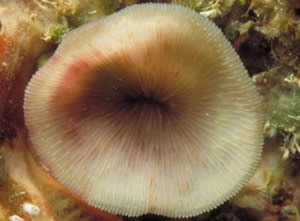
A new cave dwelling coral has been discovered. Dr. Bert W. Hoeksema / Naturalis
Coral specialist Dr. Bert W. Hoeksema of Naturalis Biodiversity Center in Leiden, The Netherlands, recently published the description of a new coral species that lives on the ceilings of caves in Indo-Pacific coral reefs. It differs from its closest relatives by its small polyp size and by the absence of symbiotic algae, so-called zooxanthellae. Its distribution range overlaps with the Coral Triangle, an area that is famous for its high marine species richness. Marine zoologists of Naturalis visit this area frequently to explore its marine biodiversity.
Reef corals in shallow tropical seas normally need the symbiotic algae for their survival and growth. Without these algae, many coral reefs would not exist. During periods of elevated seawater temperature, most reef corals lose their algae, which is visible as a dramatic whitening of the reefs, a coral disease known as bleaching.
Most reef corals generally do not occur over 40 m depth, a twilight zone where sunlight is not bright anymore, but some species of the genus Leptoseris are exceptional and may even occur much deeper. At greater depths, seawater is generally colder and corals here may be less susceptible to bleaching than those at shallower depths. Despite the lack of zooxanthellae and its small size, the skeleton structures of the new species indicate that it is closely related to these Leptoseris corals, although it has not been found deeper than 35 m so far.
The species is named Leptoseris troglodyta. The word troglodyta is derived from ancient Greek and means "one who dwells in holes," a cave dweller. The discovery sheds new light on the relation of reef corals with symbiotic algae. The new species has adapted to a life without them. Consequently, it may not grow fast, which would be convenient because space is limited on cave ceilings. The species description is published in the open access journal ZooKeys.
